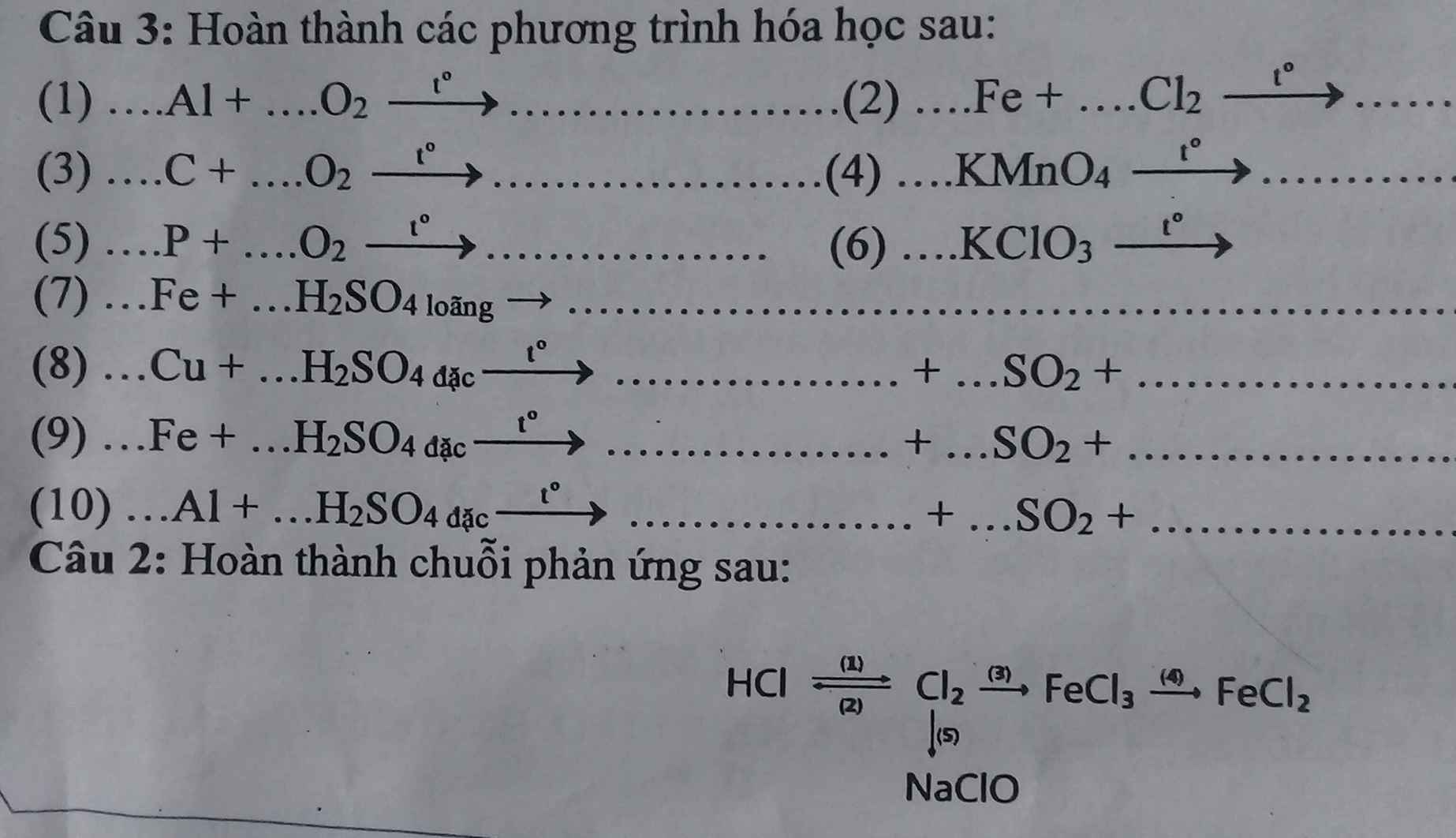Giúp e vs ạ sắp kì thi ạ 


Những câu hỏi liên quan
Mn ơi giúp e với
Làm giúp e 2 câu này ạ
Làm đc 1 câu cũng đc ạ mà 2 càng tốt ạ=))
Mong mn giúp e sớm tại e sắp thi giữa kì r :((
Câu 2
\((1) MnO_2 + 4HCl \to MnCl_2 + Cl_2 + 2H_2O\\ (2) Cl_2 + H_2 \xrightarrow{as} 2HCl\\ (3) 3Cl_2 + 2Fe \xrightarrow{t^o} 2FeCl_3\\ (4) 2FeCl_3 + Fe \to 3FeCl_2\\ (5) 2NaOH + Cl_2 \to NaCl + NaClO + H_2O\)
Đúng 2
Bình luận (0)
\((1) 4Al + 3O_2 \xrightarrow{t^o} 2Al_2O_3\\ (2) 2Fe + 3Cl_2 \xrightarrow{t^o} 2FeCl_3\\ (3) C + O_2 \xrightarrow{t^o} CO_2\\ (4) 2KMnO_4 \xrightarrow{t^o} K_2MnO_4 + MnO_2 + O_2\\ (5) 4P + 5O_2 \xrightarrow{t^o} 2P_2O_5\\ (6) 2KClO_3 \xrightarrow{t^o} 2KCl + 3O_2\\ (7) Fe + H_2SO_4 \to FeSO_4 + H_2\\ (8) Cu + 2H_2SO_4 \to CuSO_4 + SO_2 + 2H_2O\\ (9) 2Fe + 6H_2SO_4 \to Fe_2(SO_4)_3 + 3SO_2 + 6H_2O\\ (10) 2Al + 6H_2SO_4 \to Al_2(SO_4)_3 + 3SO_2 + 6H_2O\)
Đúng 1
Bình luận (0)
Talk about life on another planet.
giúp e vs ạ!!
em sắp thi nói rùi:((
Bạn tk:
The gas giant Jupiter, the next planet beyond Mars in the solar system, is inhospitable to life in any currently imaginable form. But its icy moons – especially Europa – have potential. A number of missions have flown past Jupiter and its moons on route to other places, but Nasa’s Galileo mission was the first designed to specifically orbit the planet and study its moons. It collected images and data in the Jovian system from 1995 to 2003, passing Europa 12 times.
Jupiter’s moon Europa is one of the most likely places to harbour life outside Earth, with its liquid oceans and gravitational energy sources
Pictures and data collected by this spacecraft suggest that Europa has a layered structure like Earth: an iron-rich core, a rocky mantle and a crust of ice. Magnetic field measurements found an electric current inside, consistent with a salty liquid ocean beneath the thick crust of ice around the whole planet. Photographs showing huge cracks in the ice, taken by the same mission, support this idea.
Europa’s surface resembles Earth’s sea ice in Antarctica, explains François Poulet from the Institute of Space Astrophysics at the Université Paris-Sud in France: ‘It indicates that the ice is geologically pretty young and it could be proof of its interaction with a reservoir of liquid water.’ In December 2012, the Hubble Space Telescope also detected water vapour above Europa’s South Pole and it was proposed this came from erupting water plumes. Spacecraft have not yet seen these plumes, however, so if they do exist they must be intermittent.
So, Europa probably has water. But what about the other two necessary components to be habitable? It has a source of heat energy coming from the friction of being pulled towards Jupiter’s gravitational field by different amounts during different stages of its elliptical orbit. There is also plenty of radiation around Jupiter to potentially start chemical reactions (strong enough to also very quickly destroy any organic compound formed). But whether it has the correct raw chemical ingredients isn’t yet known; modelling suggests that it might, but more hard data is needed.
In 2022, both the European Space Agency (ESA) and Nasa plan to launch spacecraft that will get up close and personal with Europa. ESA’s Jupiter Icy Moons Explorer (Juice) will take over seven years to reach the Jovian system. ‘We will arrive at the end of 2029 and start operation during 2030,’ says Poulet, a member of the team developing the visible and infrared spectrometer onboard called Majis (Moons and Jupiter Imaging Spectrometer). The main target of the Juice mission is Ganymede, another of Jupiter’s moons, but Europa will receive two flybys. Majis will characterise the surface composition of this moon and – together with the UV spectrometer onboard – determine the composition of Europa’s very thin atmosphere. Other cameras and spectrometers will also help build understanding of this icy world’s interior and crust.
For Nasa’s Europa Clipper mission, Europa is the star of the show. While the seemingly obvious mission would be to orbit Europa for a few years, any spacecraft doing this would be exposed to life-shortening radiation from Jupiter. Instead, Europa clipper will orbit Jupiter, dipping in and out of its radiation belt. It will carry out at least 45 close flybys of Europa over three and a half years. A mixture of cameras and spectrometers will examine the moon and its tenuous atmosphere. If the water plumes above the South Pole do exist, it will also be able to fly through these and therefore directly measure the chemical composition of the moon’s ocean. If the Europa Clipper launches in 2022, there are two possible arrival times for it: 2025, if Nasa’s new Space Launch System (SLS) that is currently in development is used, or January 2030, if a traditional rocket is used.
Đúng 1
Bình luận (1)

Giúp vs ạ! Mình sắp thi r ạ!!
Sau 2 phút = \(\dfrac{1}{30}\) giờ thì máy bay bay đc \(\dfrac{1}{30}\cdot300=10\left(km\right)\)
Do đó máy bay ở độ cao \(10\cdot\sin25^0\approx4\left(km\right)=4000\left(m\right)\)
Đúng 2
Bình luận (0)
sức khỏe người mẹ ảnh hưởng thế nào đến thai nhi?
giúp e vs ạ, sắp thi r
bn học lớp mấy ở lớp 8 mk chư thấy câu hỏi này bao giời ??/''
mk ko chắc là bn học lớp 8![]()
Đúng 0
Bình luận (0)
Bạn vào thư viện bài giảng điện tử nha có đấy
Đúng 0
Bình luận (0)
Xem thêm câu trả lời
Mng ơi cho e hỏi môn Hóa lớp 8 HKI trọng điểm quan trọng có nguy cơ ra thi là gì v ạ. Do e bị dốt Hóa mà e sắp kt HKI r. Ai giúp e vs. Ai trl e hứa sẽ tặng sp ạ.
Hoá học 8 kì I, em cần phải phân biệt thế nào là chất, thế nào là vật thể, phân biệt đâu là đơn chất, đâu là hợp chất. Em cần biết lập CTHH của hợp chất, của phân tử khi cho hoá trị hoặc tính hoá trị của các nguyên tố có trong hợp chất. Em cần nắm chắc biết cách tính phân tử khối của phân tử. Em cần phải biết tính khối lượng tính bằng gam của nguyên tử, của hợp chất. Biết cách lập tỉ khối. Một số dạng bài cơ bản về các hạt cơ bản của nguyên tử (proton, electron, notron). Cần phải phân biệt được đâu là hiện tượng vật lí, đầu là hiện tượng hoá học. Biết biểu diễn sơ đồ phản ứng, biểu diễn PTHH, đọc tỉ lệ số phân tử, nguyên tử các chất có trong PTHH. Những dạng tính toán cơ bản theo CTHH, những dạng tính toán cơ bản đến nâng cao theo PTHH,..
Đúng 4
Bình luận (0)
hmmm bạn nên học lại hóa từ cơ bản
bạn nghĩ hóa khó nhưng ko phải đấy là bạn chưa học thôi
Đúng 1
Bình luận (3)
giúp mik vs ạ sắp thi r

giúp em vs ạ sắp thi rùi
Lời giải:
$A> \frac{1}{5.6}+\frac{1}{6.7}+\frac{1}{7.8}+...+\frac{1}{100.101}$
$A> \frac{6-5}{5.6}+\frac{7-6}{6.7}+...+\frac{101-100}{100.101}$
$A> \frac{1}{5}-\frac{1}{6}+\frac{1}{6}-\frac{1}{7}+...+\frac{1}{100}-\frac{1}{101}$
$A> \frac{1}{5}-\frac{101}>\frac{1}{6}$
---------------
$A< \frac{1}{4.5}+\frac{1}{5.6}+...+\frac{1}{99.100}$
$A< \frac{1}{4}-\frac{1}{5}+\frac{1}{5}-\frac{1}{6}+...+\frac{1}{99}-\frac{1}{100}$
$A< \frac{1}{4}-\frac{1}{100}< \frac{1}{4}$
Đúng 1
Bình luận (0)

giúp mình vs ạ , mình sắp thi rồi
Giúp mik vs mik sắp thi r , cảm ơn trc ạ




















